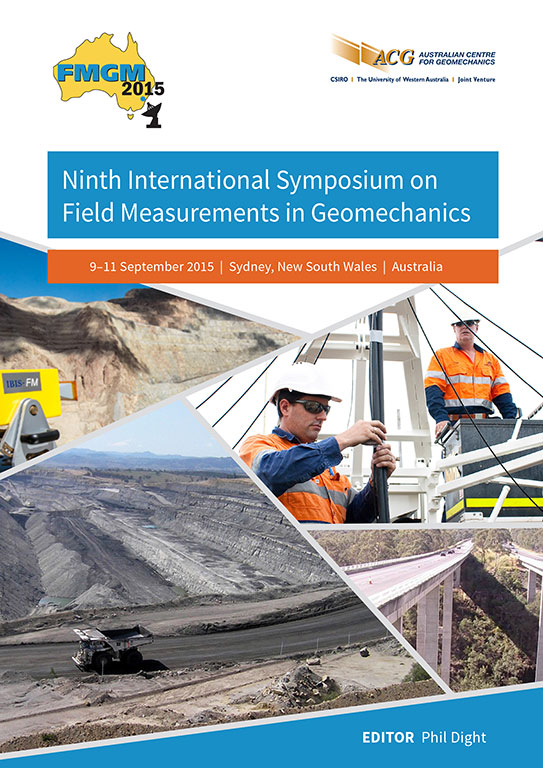Subsidence monitoring of the Seattle viaduct tunnelling project with Homogeneous Distributed Scatterer InSAR

|
Authors: Eppler, J; Kubanski, M |
DOI https://doi.org/10.36487/ACG_rep/1508_18_Eppler
Cite As:
Eppler, J & Kubanski, M 2015, 'Subsidence monitoring of the Seattle viaduct tunnelling project with Homogeneous Distributed Scatterer InSAR', in PM Dight (ed.), FMGM 2015: Proceedings of the Ninth Symposium on Field Measurements in Geomechanics, Australian Centre for Geomechanics, Perth, pp. 303-313, https://doi.org/10.36487/ACG_rep/1508_18_Eppler
Abstract:
Subsurface excavations may cause subsidence due to redistribution of stress in the overburden or changes in the groundwater state. In the case of tunnelling under urban areas, this may result in damage to existing high value infrastructure within the surface zone of influence. Synthetic aperture radar interferometry (InSAR) is a useful tool for urban subsidence monitoring because it provides measurements that are widescale and ongoing at regular time intervals. However, many existing InSAR methods such as persistent scatterer InSAR and differential InSAR do not provide sufficient spatial resolution to adequately measure short-scale spatial subsidence gradients which represent the greatest risk to infrastructure. MDA Systems Ltd. (MDA) has developed an InSAR method, Homogeneous Distributed Scatterer (HDS-InSAR), which generates higher spatial densities of measured coherent targets compared to many current methods. This is achieved through a novel combination of spatial phase filtering and coherence based target selection. This method exploits both persistent point and coherent distributed scatterers by using adaptive multilooking over statistically homogenous pixel neighbourhoods to improve the spatial resolution of the resulting subsidence maps. Furthermore, a matched parametric temporal model is fit to the deformation signal in order to enhance the detection of small amplitude subsidence. These techniques in combination provide a means for measuring small scale deformations within an urban environment and correlating their occurrence with known deformation drivers. Results are presented for the ongoing Seattle viaduct tunnelling project which consists of a 3.2 km long bored road tunnel under the city. Two satellite datasets (RADARSAT-2 Spotlight mode stacks from opposing look directions) are analysed to derive 2D (vertical + east–west) deformation maps over the area of interest spanning a time period from 2012-2015 and these results are correlated with known groundwater extraction events.
References:
MacDonald Dettwiler and Associates Ltd. 2014, RADARSAT-2 Product Description, MDA, Richmond, Canada.
Massonnet, D, Rossi, M, Carmona, C, Adragna, F, Peltzer, G, Feigl, K & Rabaute, T 1993, ‘The displacement field of the Landers earthquake mapped by radar interferometry’, Nature, vol. 364, no. 6433, pp. 138-142.
Parizzi, A & Brcic, R 2011, ‘Adaptive InSAR stack multilooking exploiting amplitude statistics: a comparison between different techniques and practical results’, IEEE Geoscience and Remote Sensing Letters, vol. 8, no. 3, pp. 441-445.
Rabus, B, Eppler, J, Sharma, J & Busler, J 2012, ‘Tunnel monitoring with an advanced InSAR technique’, Proceedings of the SPIE, The international Society for Optical Engineering, Bellingham, vol. 8361, id. 83611F–83611F–10.
Samieie-Esfahany, S, Hanssen, R, Thienen-Visser, K & Muntendam-Bos, A 2009, ‘On the effect of horizontal deformation on InSAR subsidence estimates’, in H Lacoste-Francis (ed.), Proceedings of the FRINGE Workshop on Advances in the Science and Applications of SAR Interferometry, ESA Communications, Noordwijk, 7 p.
Washington State Department of Transportation 2011, Alaskan Way viaduct replacement project: final environmental impact statement and section 4(f), WSDOT, Olympia, WA.
© Copyright 2025, Australian Centre for Geomechanics (ACG), The University of Western Australia. All rights reserved.
View copyright/legal information
Please direct any queries or error reports to repository-acg@uwa.edu.au
View copyright/legal information
Please direct any queries or error reports to repository-acg@uwa.edu.au